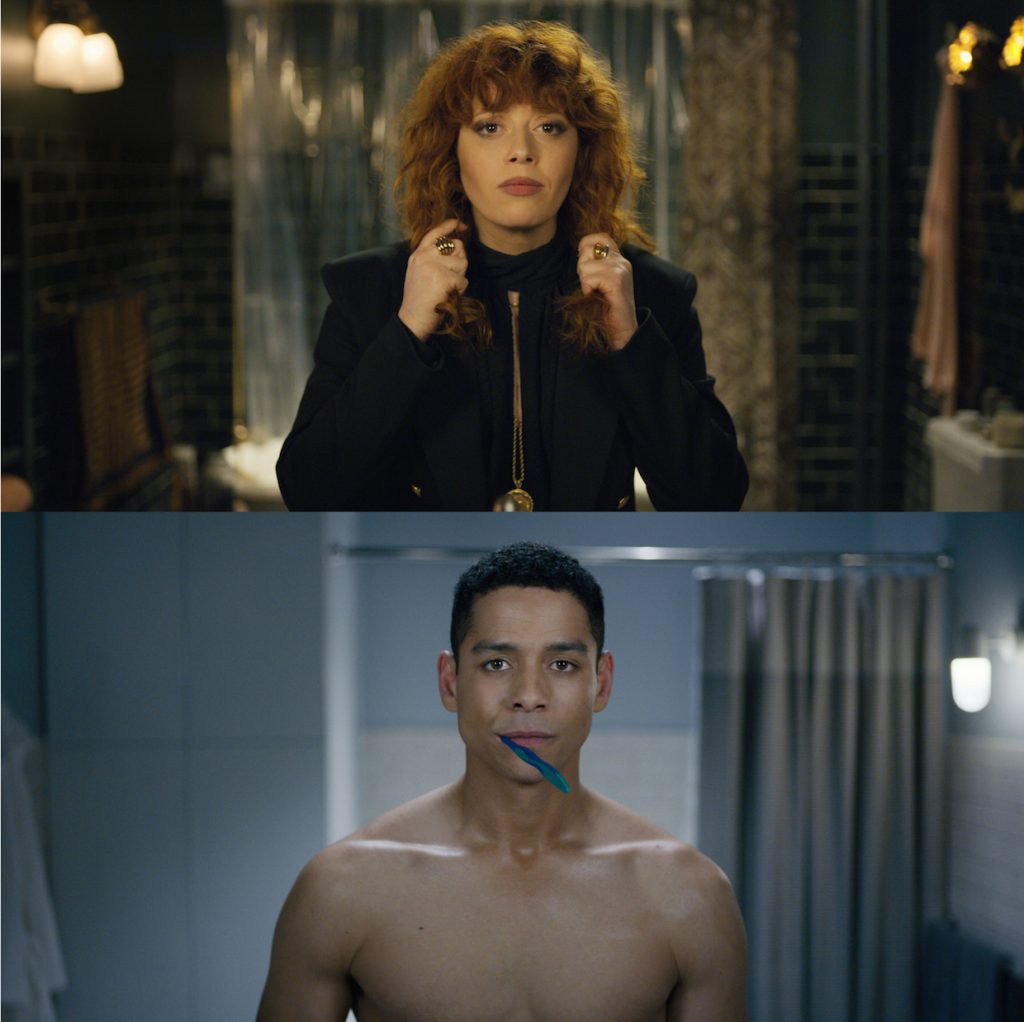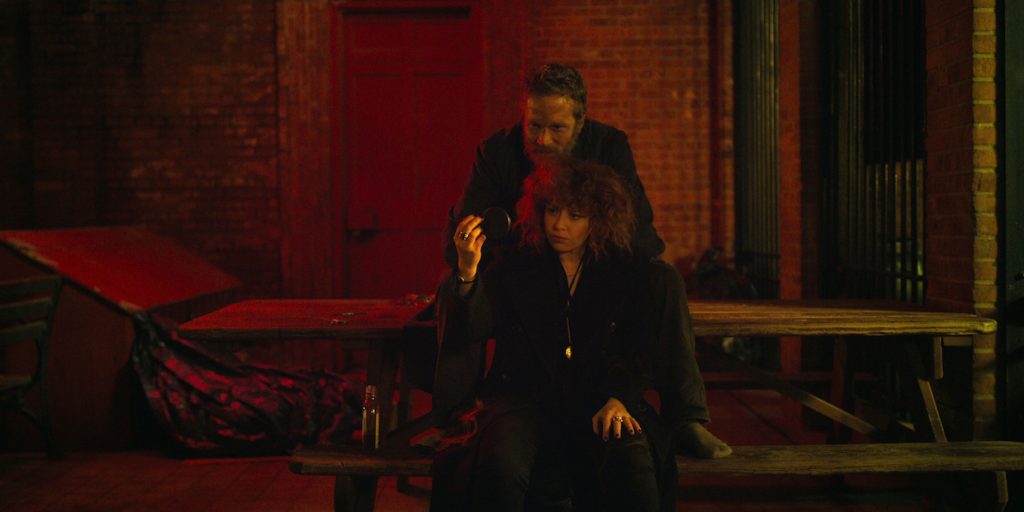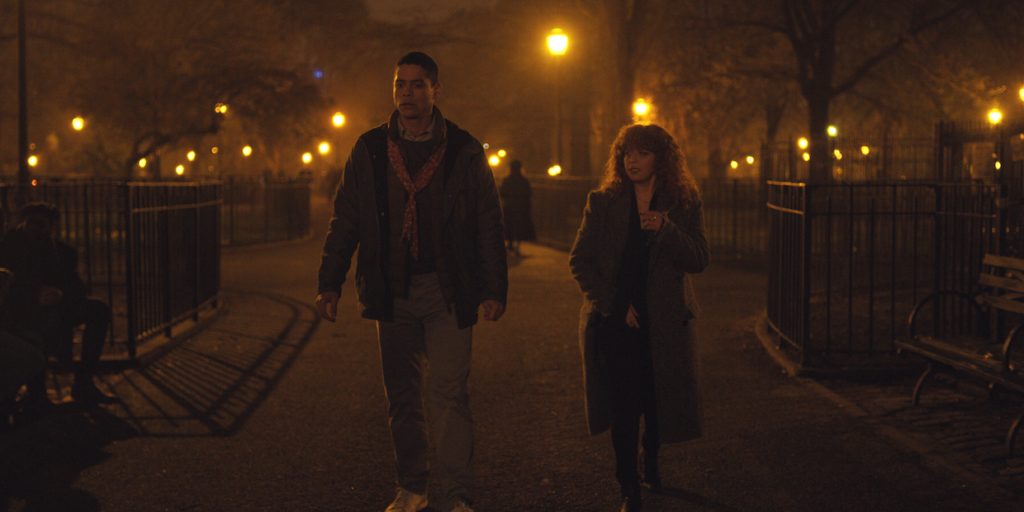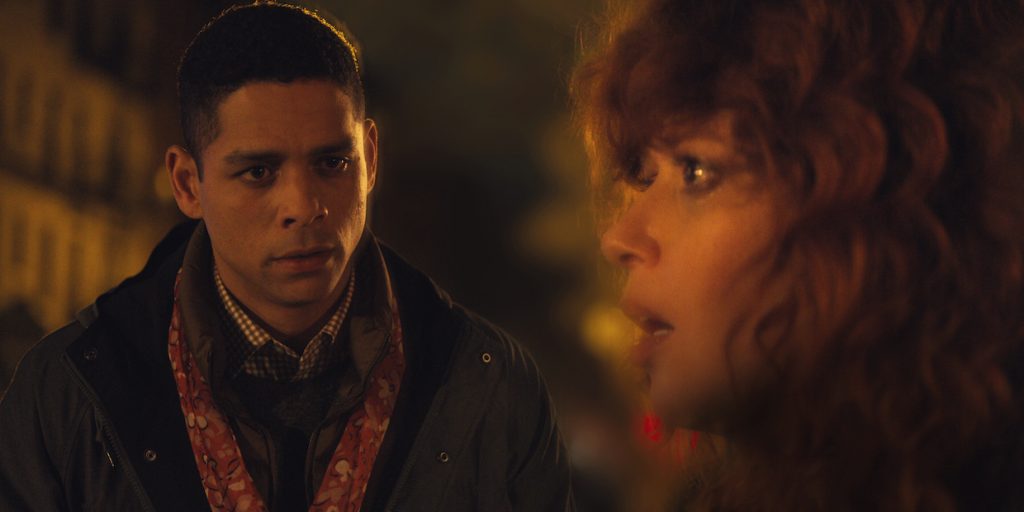 Back to selection
Back to selection
Shutter Angles
Conversations with DPs, directors and below-the-line crew by Matt Mulcahey
“I’d Spend 24 Hours with My Family, Fly Back, Sleep for Five Hours and Shoot the Next Day”: Cinematographer Chris Teague on Russian Doll
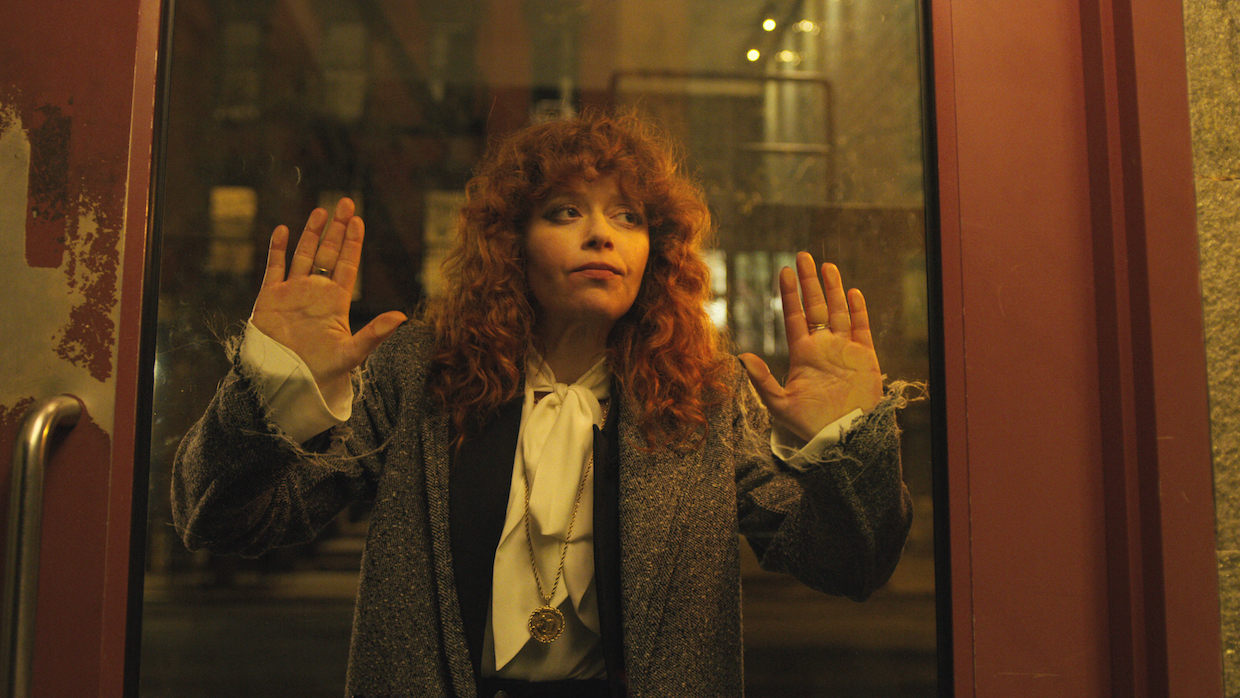 Natasha Lyonne in Russian Doll
Natasha Lyonne in Russian Doll On the night of her 36th birthday, New York video game developer Nadia (played by the show’s co-creator Natasha Lyonne) stumbles out of a party in her honor and is killed by an oncoming car. Thus begins a cycle of “resets” in the new Netflix series Russian Doll, with each demise bringing Nadia right back to the same birthday party bathroom mirror on the same night.
The Groundhog Day comparisons are unavoidable, yet as Russian Doll unfolds across its eight episodes it reveals layers of emotional complexity and existential angst that extend beyond that Bill Murray classic and its Christmas Carol-esque redeemed misanthrope.
The series was shot by Chris Teague, a veteran of New York indie films such as Obvious Child, Appropriate Behavior and Landline. With Russian Doll currently available on Netflix, Teague spoke to Filmmaker about returning to the Red, saying goodbye to old glass and futzing with split diopters.
Filmmaker: Coming from the world of indie films, where you’re shooting something like Obvious Child in 18 days, is it a tough adjustment in terms of your life when you’re working the extended schedule of a television show?
Teague: It’s extremely challenging. Russian Doll was the third show that I’ve done. I lived in New York for 15 years, but I moved to LA because my wife is a director and she’s making a movie out here. So I was trying to get hired [in LA] and I couldn’t really find anything, then Russian Doll came up and took me back to New York for three months, and I did a pilot right after that in New York as well. It was extremely difficult on everybody. I was going back and forth a lot. Russian Doll had a lot of night work. I’d do these weeks where I’d wrap at 6am at sunrise and then go straight to the airport and fly home. I’d spend 24 hours with my family, fly back, sleep for five hours and shoot the next day. It was not a very healthy schedule.
Filmmaker: If you move your production city for the union to LA, does that make it more difficult to get jobs in New York because you’re a distant hire now?
Teague: It was a concern. I was lucky because [Russian Doll co-creator] Leslye Headland knew of my work and met with me early on. I had actually worked with her wife Rebecca Henderson, who’s also in Russian Doll, on Appropriate Behavior. So Leslye was very passionate about hiring me, and the production company, Jax Media, also had worked with me on Broad City and some pilots, so they really liked me. It’s definitely an added expense for them, but they were willing to do it because of our relationship. But that was a real concern of mine when we first moved to LA, because I did change over my production city and I did it as fast as I could, because you have to stick with one for 18 months, so I wanted to get that 18-month clock ticking as soon as possible because we may still be moving back to New York. We just didn’t know what our plans were going to be. It’s definitely a tricky thing to juggle. I’m [in LA] now shooting the third season of GLOW for Netflix. It’s been amazing because I’m close to home, but it’s still a production schedule. When you have 7 or 8am calls you pretty much don’t get to see your kids during the week anyway. You’re gone through all their waking hours and just see them on the weekends.
Filmmaker: When I’ve interviewed cinematographers about Netflix shows in the past, they’re usually reluctantly using a camera other than the Alexa because of Netflix’s 4K requirement. But you’ve actually done a lot of work with Red cameras. When I talked to you a few years ago for Obvious Child, you were shooting with a Red Scarlet that you owned.
Teague: I did own a Scarlet for years and shot a lot of movies on it, but I sold it and I’ve been shooting with the Alexa for a while. So I thought I knew the Red camera, but so much had changed [since the days of the Scarlet] with the sensor technology and the new bodies and all the naming formats. For Russian Doll I tested the Dragon and also the Helium sensor, which is 8K. I was initially thinking, “I don’t know why we need all this extra resolution. We have to deliver in 4K, why don’t we just shoot 4K?” But then when I looked at our tests, I was won over by the Helium. It’s better to shoot at a higher resolution than you need because the texture is much better. Also when you start goosing up the ISO—we shot Russian Doll mainly at 1600—you start adding noise and at that high resolution it has a nice quality to it, a nice texture that’s like a finer grain. It takes the edge off the digitalness of it.
But it was a bit of a learning curve for me. I was planning on shooting with a Dragon sensor, but a few weeks before [principal photography began on Russian Doll] my colorist Nat Jencks said, “You should really test the Helium with this new color science they have, the IPP2 color pipeline.” I’m so glad we did because I was really happy with the results. I thought the skin tones looked better and I really liked the way the color looked. Luckily we were able to change out our bodies like a week before shooting from Dragons to Heliums.
Filmmaker: Did you even shoot the day exteriors at 1600?
Teague: I believe we shot the day exteriors at 1600 just to be consistent. I would’ve loved to have used LiveGrain on this, which I did on Landline and thought it looked amazing, but I knew that the production company wouldn’t spring for the expense, so I wanted to build as much noise into the image as we could. We did add some post grain as well, but with some of the other post grain filters you can only add so much before it becomes really noticeable. LiveGrain you can push a lot farther.
We did shoot a few scenes at 3200. The rooftop location at Alan’s apartment was one of those New York locations that didn’t want us there anymore by the end of the shoot. [In the series, Nadia crosses path with another character named Alan stuck in the same time loop.] The last night we shot there we weren’t allowed to do any lighting from the street or from other buildings. We could only put lights on the actual rooftop. So we were wide open at 3200, which luckily this show has such a wild look we could do things like that and it didn’t feel out of place.
Filmmaker: You owned a set of Cooke Speed Panchros for years, but for Russian Doll you went with Leica Summilux lenses.
Teague: Yeah, I shot almost everything on vintage lenses before Russian Doll. They didn’t feel appropriate for this except for the flashback sequences in episode seven, which we shot on Super Baltars. This felt like a modern, contemporary, hyper-real landscape and I loved the idea of having super fast lenses that I could shoot wide open all the time. The concept in my head, which is maybe too literal, was that Nadia was out of step with her world, and if we used fast lenses with very shallow depth of field she’d always feel like she was popping out of her background. I really fell in love with how those lenses look. The wide lenses [have minimal distortion], so we could do some things on super wide lenses. I shot a couple of scenes on a 16mm lens and I never would’ve done something like that before. I love a wide lens where you have that incredible open field of view, but you’re not so distracted by the way it’s warping the space. The Leicas are fantastic lenses. They’re also small and light, so we could keep the camera’s [footprint] smaller. That was a plus when shooting in tiny New York locations.
Filmmaker: Because of the show’s unique structure—where you’re reshooting the same scenes over and over but with slight variations—I’m interested in how you scheduled the work.
Teague: Basically we did block shooting. We block shot episodes 1-3, then 4-6 and then 7-8, but within those blocks we dropped in all the stage shooting in this 12-day lump right in the middle.
Filmmaker: What was done on stage?
Teague: Only the apartment [where Nadia’s birthday party takes place] and Alan’s bathroom, which was designed to be a mirror image of Nadia’s bathroom.
Filmmaker: Right, there’s even a shot where we see both of those sets together in profile.
Teague: Yeah, that’s a practically shot image. It’s not a split frame.
Filmmaker: So when we’re looking at Alan or Nadia from the mirror’s point of view, are you flying that wall out or did those mirrors swing out of the way for the camera to shoot through?
Teague: We probably just could’ve done a camera port, but we weren’t sure how much we were going to want to move the camera for those shots, so we ended up taking the wall out when we needed to do those.
Filmmaker: Tell me about the challenge of contrasting the worlds of Nadia and Alan. She’s an out-of-control character and he’s a complete control freak.
Teague: It wasn’t a challenge as much as an opportunity. You get locked into one style with your main character, so it was great to have this opportunity to flip that, to say “What’s the opposite [of Nadia’s world] in terms of color and quality of light?” The loft apartment [where Nadia’s birthday party takes place] was going to be warm and yellow, with a lot of practicals. Michael Bricker, the production designer, went in a completely different direction with the color themes in Alan’s apartment and we pitched in on that too, with a cooler, crisper kind of light, brighter and more filled in. The trick with that was going brighter, but still maintaining the mood of the show. We didn’t want to turn Alan’s apartment into a sitcom.
Filmmaker: So you shot the party in one long stretch—everything for all eight episodes. Did you do everything in the bathroom consecutively and then everything in the kitchen in a row?
Teague: We would try to shoot the rooms out as much as we could just because it’s more efficient, but there were some places where that was challenging, like the bathroom where Natasha is doing all these resets. A lot of them don’t have any dialogue and sometimes it is the same shot [for different scenes], so we had to be very tuned in to where in the story the shot was happening. It got really confusing, because we’d shoot eight of them in a day and have to be like, “So we’re halfway through episode two at this point, so we’ve already seen her reset two times in this episode so this one should be tighter, and the cuts will be quicker, but then this other reset comes off of this really traumatic moment, so we’re going to want to be with Nadia for longer.” Those scenes were very challenging for Natasha to stay in the right moment, because she’s going through these dramatic leaps as a character but you’re in the same location and shooting them five minutes apart from each other.
When you’re shooting the same scene in the same location five times in a row, you start to wonder “Am I just changing this up because I’m bored or am I changing it up for a real narrative reason?” You have to take a step back and think about how it’s going to fit in the edit. I watched Groundhog Day, of course, and some sequences are shot almost identically each time. It is affecting, because when you see the same shot over and over again, the small differences are very apparent. But Nadia’s character is quite different from the Bill Murray character in Groundhog Day. The moments are quite different. There are moments that are very charged and they feel like they need a moving camera that’s very connected to Nadia. Then there are moments where we want to step back and let her not drive the frames as much.
Filmmaker: The show has a very distinct palette. I read an interview with Leslye where she said Ladies and Gentlemen, the Fabulous Stains was the main reference for the colors. I haven’t seen that one.
Teague: I had never seen it before either. [It was referenced[ in the script, so I watched it and it was right up my alley. It’s one of these lost 1980s punk rock movies like Repo Man, which is a favorite movie of mine. Robby Müller does amazing things with color, so he’s a real inspiration with his work in Repo Man and Paris, Texas.
We pulled a lot of reference images from different movies and still photographers. Then I took that lookbook and cut out squares of color from images that felt right for the show and built this mosaic of different color tiles. I gave them to Nat, my colorist, and Joel Minnich, my gaffer, and that became our jumping off point for our palette. Joel then took all our RGB LED units, like our Asteras and our SkyPanels, and built colors to match those swatches.
Filmmaker: Tell me more about using the Asteras. Are they powerful enough to be a key or are you using them for background washes of color?
Teague: For both. They’re definitely bright enough to light a scene in a small space and they’re amazing because you can tie them into a tablet and dial in whatever color you want. The thing I learned, though, is that when you’re working with really saturated colors, they can look completely different to your eye than they do on camera. There’s a scene [where Nadia visits a drug dealer in the basement of a bar]. I had initially intended to make it look like a deep blue green, more like a cyan color, and that’s what we had dialed in on our lights when we pre-lit. But when we got our camera in there, the camera wasn’t picking up on the green. It was just looking like a pale, ugly blue and we couldn’t really get that specific tone dialed in on the camera, so we had to go in a different direction with it. I’m not sure what exactly to attribute that to. I think part of it is the camera sensor, part of it is the LUT that we were working with shifting colors around in specific ways.
Filmmaker: The Asteras are nice because the battery is built into the tube, so it’s not like the old Kinos where you had header cables and a ballast to deal with. I was working on this commercial last week that shot in a warehouse. The gaffer had these magnet backings on them so he could just stick the tubes right to this warehouse’s racks.
Teague: Yeah, they’re amazing, and they’ll give you a couple of hours of runtime on the battery. When we were shooting our city street scenes, we’d put them on these vertical little stands and tuck them into doorways and around corners, wherever we could, to get little washes of color.
Filmmaker: You touched on this a little earlier, but tell me more about shooting the flashbacks to Nadia’s childhood in episode seven on those Super Baltars.
Teague: That was so much fun because it came at the end of the show. On a TV show, you’re trying to keep the look consistent, and you’re doing similar techniques over and over again to maintain that consistent look. When you’re two or three months into a show, to have an opportunity to do something different was so much fun. We used Super Baltars and really heavy diffusion filters—probably Hollywood Black Magic or Pearlescent or something like that—then tried to flare the lens whenever we could, using hard light, to try to create this feeling of a memory that was completely detached from the rest of the show.
Filmmaker: For the scenes in Tompkins Square Park, where Nadia searches for her missing cat, the lights are warm sodium vapors. So many cities are going to LED bulbs with neutral white light. Is that park actually still sodium vapor?
Teague: It is still sodium vapor, luckily, but as we were shooting [the city was] switching out bulbs on the streets around us. One thing we learned through testing is that with the Red camera, shooting at 5600 produced a much better color for the sodium vapors than shooting at 3200. I felt it was a truer color, more yellow and less red. Our technique in that park ended up being to cover or turn off whatever lights were close to our actors and replace them with our own units—usually SkyPanels that we would match to the sodium vapors, but with a color that was a little friendlier for faces. We didn’t have the resources to do much more than that. We occasionally used a lift to push some of our color from the show—like some Cyan on a Par Can and do a little wash in the background to make it not so monochromatic—but usually we had to embrace the exteriors the way they were.
Filmmaker: Episode two features a “Nadia-cam” rig with the camera attached to Lyonne and facing back at her. I’m guessing the Red was a little too heavy to use for that rig.
Teague: We used a Sony a7S II with Zeiss still lenses. Our colorist Nat built a LUT transform for SLog3 and it matched surprisingly well to the [Helium footage]. Natasha was such a trooper. The rig itself, with all the pipe you need to support it, was really heavy, but she really got into it. We were talking about it afterward and she was like, “I loved the experience of being the actor, the camera operator and sort of the director all in one package.”
Filmmaker: And she actually ended up directing the show’s final episode, which has a couple of nice split diopter shots.
Teague: Those split diopters were all Natasha’s idea. She’s a total cinephile. She loves Brian De Palma and wanted to find a way to use the split diopters, which I really hadn’t used much before.
Filmmaker: So with a split diopter, half the filter is basically empty—there’s no glass—and then the other half is the diopter, which magnifies. So you’re putting the diopter portion on the person in the foreground?
Teague: Right, then you have a narrow window of focus where you can place the [foreground] actor. Then, if it doesn’t work for the composition, you switch out to either a weaker or stronger diopter. We would line up the frame, then drop in a mid-level diopter and see how it landed. Then we’d futz around with it until we got the composition we wanted and everything in focus.
Matt Mulcahey works as a DIT in the Midwest. He also writes about film on his blog Deep Fried Movies.
